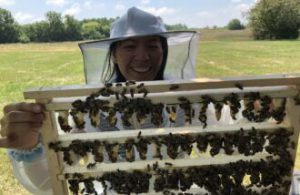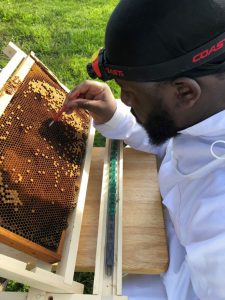
Hongmei Li-Byarlay is working to improve the quality and quantity of queen bee production in Ohio. Photo courtesy of the Li-Byarlay Lab.
Ohio beekeepers are losing 50-60 percent of their managed bee colonies each year, according to Hongmei Li-Byarlay, Associate Professor of Entomology at Central State University. Li-Byarlay studies the genetics and behavior of honey bees and believes mite-resistant bees could help improve Ohio honey bees. Her research lab focuses on honey bee genetics and behavior, and recently she has been exploring queen bee quality and genetic diversity.
“Promoting mite-resistant bees is one of the most effective ways to mitigate bee decline,” said Li-Byarlay. “We have a collection of bee stocks from feral colonies that are mite resistant with high mite biting behavior. However, the limiting factor is too few queens and nuclei available to fulfill the demand of local beekeepers.”
With support from an NCR-SARE Partnership Grant, Li-Byarlay’s Lab worked with experienced queen producers in Ohio to improve the queen quality of honey bee stocks in Ohio.
“We want to improve the beekeepers’ understanding of the biology of queen bees and help to transfer and distribute favorable genetics to more bee farmers,” said Li-Byarlay. “The outcome is to improve the quality and quantity of queen production in the region.”
The Art of Grafting
Commercial queen bees start their lives through an activity that queen rearers call “grafting.” Grafting is when queen bee producers transfer young larvae from breeder queens into cell-building colonies. The traditional grafting process takes ten days and requires specialized knowledge and resources.
For this SARE project, Li-Byarlay successfully used a relatively new 48-hour method of grafting. This abbreviated 48-hour method is promising because it’s faster and requires fewer resources than traditional queen-rearing.
“For many beekeepers, the bottleneck to diversifying their queen genetics is finding an affordable price for queen purchasing,” said Li-Byarlay. “Our approach is to lower the cost by providing 48-hour queen cells. At the same time, beekeepers can have more diversity in their queen and honey bee colony genetics in their backyard, which will promote more outbreeding and less inbreeding.”

Xaryn Cleare, an alumnus of the Li-Byarlay Lab, transfers young larvae from breeder queens into cell cups. He will place these in a nutrient-rich starter hive. The queen cells will then hatch into future queen bees. This process is called “grafting”. Photo courtesy of the Li-Byarlay Lab.
Feral vs. Commercial Bees
The team studied feral, Russian and commercial package bees when looking at the egg-laying behavior/rate of queens from different bee stocks. Queen cells from Russian stock, feral colonies and commercial queen stock emerged, mated and were placed into new nuc colonies with the same amount of worker bees.
Results showed that the feral bees had a higher egg-laying rate than the commercial bees. The team hosted field days to demonstrate how to do queen rearing and make 48-hour queen cells. 100 queen cells from their mite-resistant stocks went home with workshop participants. They also held several workshops on how to make and use swarm traps to catch feral bee colonies.
“Overall, we have had a broad impact on the change of knowledge in queen rearing, genetics and breeding in Ohio, especially in Southwestern Ohio regions,” said Li-Byarlay.
NCR-SARE starts accepting Partnership grant proposals in mid-August. Learn more at https://northcentral.sare.org/Grants/.
Want more information? See the related SARE grant:
Improving the Honeybee Queen Qualities and Genetic Diversity by Transferring Selected Queen Cells (ONC19-062) https://projects.sare.org/sare_project/onc19-062/
Originally published at https://northcentral.sare.org/news/improving-honeybee-queen-quality-and-diversity-in-ohio/






